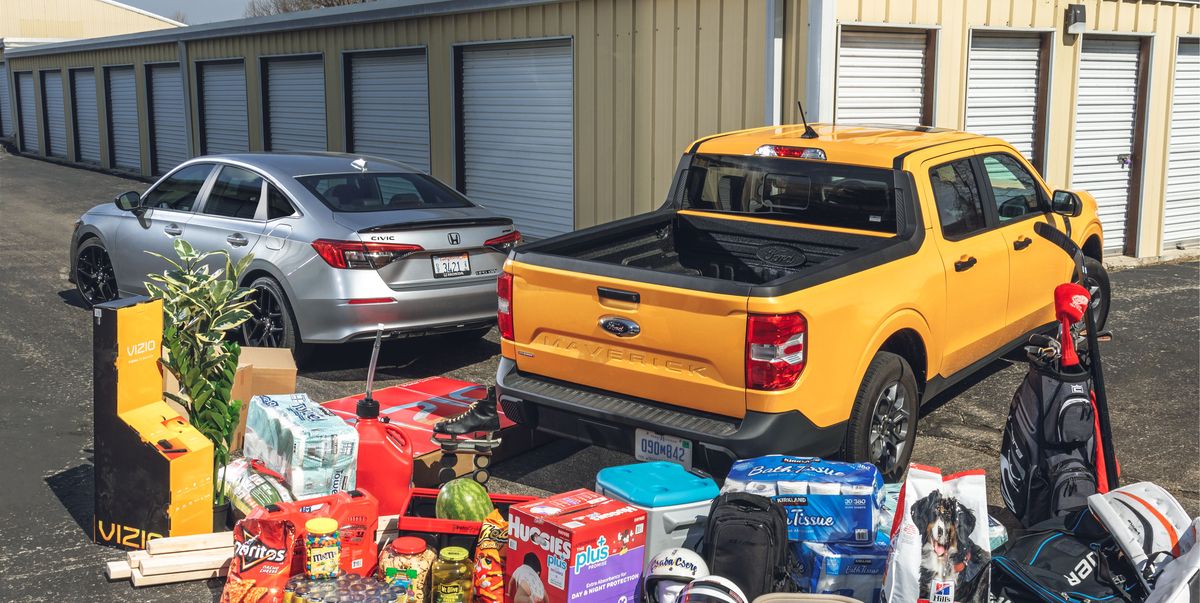Buying Culture: 2022 Ford Maverick XLT vs. 2022 Honda Civic Sport

From the June 2022 issue of Car and Driver.
Americans own a lot of crap. So much, in fact, that there’s a whole TV industry devoted to our bottomless appetite for acquisition. Pawn Stars, American Pickers, Storage Wars, Hoarders—these shows revolve around our possessions, how we accrue and dispose of them, how they come to rule our lives. For many of us, our mountainous volume of belongings outstrips the size of our homes (consider that construction of personal storage units increased 584 percent between 2015 and 2020). And if the junk has to go somewhere, it also has to get there. Which is why the hottest new economy car is a pickup: the 2022 Ford Maverick.
Michael SimariCar and Driver
Michael SimariCar and Driver
Like any good consumer, we went on a Costco run to see what fits in each vehicle. It’s no surprise that the Civic owner will have to leave a seriously fun evening of activities behind.
The Maverick’s earnest usefulness seems to demand few sacrifices. Unibody with a strut front and torsion-beam rear suspension, it drives more like a Bronco Sport than a Ranger. The standard model is a hybrid with an EPA fuel-economy estimate of 37 mpg combined. Its base price is $21,490, and the truck can tow 2000 pounds and haul 1500 pounds in its bed. The Maverick offers 191 horsepower in hybrid form and 250 horses with a turbo 2.0-liter four. So what’s the catch? Why wouldn’t you just buy one of these instead of, say, a Honda Civic? We were asking ourselves the same thing, so we decided to grab a $26,645 Maverick XLT hybrid and a $26,183 Civic Sport sedan and find out for ourselves whether Ford’s small truck could make the small car obsolete.
Redesigned for 2022 and just off a recent comparison-test win, the Civic is a lodestar for small-car excellence. It looks, drives, and feels expensive, yet its base price is $23,365. You can tell that Honda has been in this game for a long time. Most cars around this price strive for nothing more than cheerful chintz inside, but the Civic Sport wants you to notice the metallic honeycomb spanning the dash, the softness of the leather wrapping the steering wheel, and the fact that the trunk-release button lights up, so you can rely on sight, not feel, to find it. The Civic, as always, nails the details. The question is whether the Maverick delivers a broadly similar experience along with the ability to haul that irresistible Craigslist dinette set to the local U-Stor-It.
Michael SimariCar and Driver
On a winding back road, it doesn’t take long for the Civic to establish that “carlike,” as applied to the Maverick, is relative. Fitted with 18-inch wheels and 235/40R-18 Goodyear Eagle Sport All-Season tires, the Civic pulls 0.87 g on the skidpad and feels willing to venture near that number whenever a suitable corner presents itself. Even fragged-out Michigan pavement can’t knock it off its line once it takes a set; the suspension is stiff enough to keep body motions in check yet supple enough to soak up big hits. The Civic feels light and lithe, and it is, weighing in at 2906 pounds—814 pounds less than the Maverick.
Michael SimariCar and Driver
Michael SimariCar and Driver
The Maverick’s underseat storage is the only place in the little truck where you can hide your affinity for summer sausage and Doritos from judging eyes.
The Maverick, by contrast, is like a big goofy dog trying to keep up with a greyhound, bounding and leaning and generally feeling distinctly unhappy at being hustled. Compared with the Civic, its 17-inch wheels are smaller and its 225/65R-17 sidewalls are taller, which helps make for a limber ride but adds another layer of squish in corners. The Maverick manages a not-terrible 0.81 g on the skidpad, but attaining that number requires torturing the front tires with drastic understeer. Even its plastic steering wheel discourages spirited driving, drawing one comment that read, “I’ve felt more luxurious steering wheels on a municipal golf course.”
When the road straightens, however, the Maverick regains some ground. While both Honda and Ford use a continuously variable automatic transmission (CVT), the Maverick’s 173 pound-feet of electric-motor torque helps get things moving while the 2.5-liter Atkinson-cycle inline-four climbs toward its 5600-rpm power peak. The Maverick’s 7.7-second sprint to 60 mph trounces the Civic’s 8.8-second run, and the chunky Ford beats the Honda in every other acceleration test too. From 50 to 70 mph, the Maverick is a full second quicker (4.7 seconds to 5.7 seconds), a margin that also applies to the quarter-mile (15.9 seconds at 90 mph versus 16.9 seconds at 86 mph). Should you keep the pedal pinned, the Maverick will require 27.3 seconds to reach 110 mph; the Civic, 32.0. As these numbers suggest, the Civic Sport’s sportiness does not extend to its powertrain.
Michael SimariCar and Driver
2022 Ford Maverick XLT
Highs: Efficient, inexpensive, can carry manure much more elegantly than the Civic.
Lows: Still mildly truckish handling, cheapo interior, fun-killing CVT.
Verdict: A great little car that happens to be a truck.
2022 Honda Civic Sport
Highs: Beautifully executed interior, playful handling, surprisingly capacious.
Lows: No manual transmission, HPD package promises speed that’s not there, can’t tow your Sea-Doos.
Verdict: Buy this and borrow your friend’s Ridgeline sometimes.
Michael SimariCar and Driver
In fact, the Civic Sport sedan comes only with the most milquetoast of Civic powertrains: a 158-hp naturally aspirated 2.0-liter inline-four paired with a CVT. With a mere 138 pound-feet of torque manifesting at 4200 rpm, the 2.0-liter takes a while to generate meaningful forward progress—the Sport’s off-the-line lethargy earned it the nickname Less 2000. The Civic does have paddle shifters that let you choose from six preset ratios, and Sport mode keeps the 2.0-liter spinning above 3000 once you’re on the move. Compared with the Maverick, the Civic has the sportier CVT. And an Irish funeral is probably more fun than most others, but you’d still rather be at a Dave & Buster’s.
Michael SimariCar and Driver
Michael SimariCar and Driver
Filling a Maverick with dirt or mulch would be no problem. A Civic owner will have to buy their stuff bagged, which, let’s be honest, isn’t nearly as cool.
We should note that this Civic Sport wore the Honda Performance Development cosmetic kit, a $1418 package that brings lower-body appliqués, a rear decklid spoiler, and an all-important HPD badge. It does not, as far as we could tell, make the car go faster. However, for $182 more, you could upgrade to a Civic EX and its 180-hp turbocharged 1.5-liter four, a powerplant that gets the Civic to 60 mph in 7.5 seconds. Then again, if you spend an extra $1085 on your Maverick, you could have the 250-hp turbocharged 2.0-liter four. Spend even more, and you could probably have a 1000-hp Chevy El Camino with an airbrushed unicorn on the hood, so maybe let’s just quit the what-ifs and move on to cargo.
Michael SimariCar and Driver
To put it in the simplest terms, the Civic is better at hauling people, and the Maverick is better at hauling stuff. But the Maverick’s cargo-schlepping superiority isn’t as dominating as expected. In a modified version of our standardized box test (we don’t normally fill pickup beds with boxes), the Maverick held 28 boxes in its bed (filled to the rail) and back seat. The Civic swallowed a surprising 20 boxes with its rear seats folded. The Civic also has the advantage of its rear-located, lockable, out-of-sight, weatherproof storage compartment, which Honda calls a “trunk” and is quite a novelty these days. However, it will be much more difficult, and certainly messier, to stuff a Yamaha YZ250 dirt bike into the Honda—advantage Maverick here. Ditto with towing, moving grandfather clocks, and sitting on the tailgate and drinking a thermos of coffee while wearing a hard hat. We’re afraid you’ll need the truck for that.
Michael SimariCar and Driver
Michael SimariCar and Driver
If you choose to haul people in the rear seat and leave the stuff to the cargo areas, then you will find the Maverick’s advantage for moving things grows.
But if your cargo, like Soylent Green, is people, the Civic is the machine you want. Its seats, both front and rear, are all-day comfortable, while the Maverick’s front seats lack thigh support and the back one is overly upright. The Civic’s softer interior materials seem to translate to better sound quality in the cabin, despite the decibel meter’s insistence that the Maverick is actually quieter. And for that piece of cargo known as the driver, the Civic wants to make life a little smoother with keyless start and adaptive cruise control, both of which our Maverick lacked.
We can’t deny the Maverick’s utility, but after hours behind the wheel of both vehicles, we realized that the mini-truck isn’t quite the no-brainer choice it seems on paper. To attain that all-important bed, you sacrifice comfort, refinement, and handling—to an extent that becomes obvious once there’s a Civic alongside. But those are differences of degree, not of kind, and the Maverick can still function as a car a lot more effectively than the Civic can function as a truck. If your life includes a lot of things, then the Maverick might be one more thing you need.

A car-lover’s community for ultimate access & unrivaled experiences. JOIN NOW
This content is created and maintained by a third party, and imported onto this page to help users provide their email addresses. You may be able to find more information about this and similar content at piano.io


